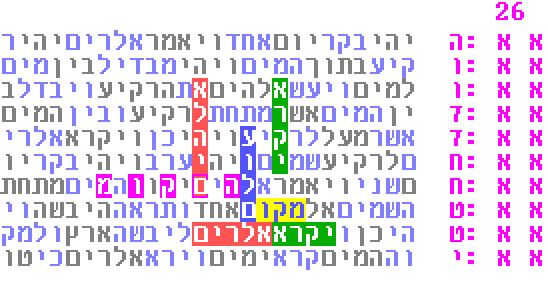Parallel Study
Motivation for the Parallel Study
The first parallel example below was
observed some time ago, without using a strict protocol.
Nonetheless, it is interesting (and encouraging), and it
was the motivation for studying the parallel pattern in a systematic way.
It shows the following ELS's, central to the ultimate vision of redemption
in Jewish thought:
Third (red)
- Temple (blue)
- The Messiah (pink)
- Son of David (green).
click for full image

Highlighted in the text in yellow are the words "this will bring us
comfort".
Summary of Parallel Pattern Rules
The first rule in the systematic study, was that there should be no freedom
at all in choosing the words to search. The words should come directly
from a lexicon (word list) generated from the Torah itself. Further, I
chose only pairs of words that occur together often, in the same verse or
verses. In addition, each word must have 4 letters or more; and for this
first attempt, I required the simplest form of parallel: the ELS's must be
side-by-side with the same skip.
Based on earlier observations of clustering, the thinking ("hypothesis")
was that
these closely associated word pairs would appear as side-by-side parallel
ELS's more often than expected; and often near the same words either in the
text or as additional ELS's; and/or near ELS's for closely related words.
Parallel Results
In fact, Genesis and Exodus searches resulted in many highly significant
tables, fitting all of the above expectations - much more than expected for
the number of cases attempted. (However, striking examples were not found
in the other three books.)
One such example from Genesis is shown below. It was rare to find the
side-by-side parallel pattern at all, but in this picture, the pattern was
found 3 times in the same spot. The pairs (from the lexicon) which all
formed parallel ELS's in this picture were:
(a) 'G-d' + 'world';
(b) 'G-d' + 'called';
(c) 'G-d' + 'and now'.
To avoid clutter, 'and now' (waw-iyan-tav-heh) is not shown in the picture,
but it shares two letters with the ELS for 'world'. The ELS's are:
G-d (red)
- called (green)
- world (blue)
- the place (pink; also highlighted in yellow from the text).
click for full image

As added interest, this picture is from very early in Genesis (chapter 1,
verses 5-10). It is the first ELS for G-d in the Torah. The phrase 'G-d
called' appears in the text 3 times in this general area, one of which is
highlighted - He is calling the light 'day', the darkness 'night', the sky
'heaven' and the dry land 'earth'. Also interesting is that the skip for
the overall picture is 26, the gematria (numerical equivalent) for the
tetragrammaton (G-d's main name).
'The place in the world' is a common, direct reference to 'G-d', but 'the
place' was chosen as a search word objectively, because it appears three
times in verses with both 'G-d' and 'called'. It appears in the picture
with extremely small skip of 2.
Example 2 from the systematic study shows the following parallel ELS
pair in the picture below
- Your reward (red), with
- (The) striped (ones) - (blue);
"striped" in Hebrew is pronounced Akoodeem actually
(accent on last syllable) - more on this below.
click for full image

"Your reward" and "striped" were chosen because they appear together 4 times
(twice each actually) in a single verse - Genesis 31:8.
Here Jacob is speaking to his
wives, Rachel and Leah (the daughters of Laban, Jacob's employer). He tells
them, if your father said to me "your reward will be (the) spotted
(ones)", the whole flock gave birth to spotted; if he said "your reward
will be (the) striped (ones)", the whole flock gave birth to striped.
To find these two words as side-by-side parallel is itself extremely
significant; occurring at this exact spot in the text makes it even more
significant: the yellow highlighted text is "your reward will be
striped (akoodeem)"; and in brown, directly below, the word "akoodeem"
again. Not as easy to measure, but very significant, are the following
additional points:
(1) Both Laban and Jacob appear in parallel as well (pink and green ELS's).
(2) The Kabbalist, Yitzchak Isaac Chavar, a student of a student of the
Gra, devotes an entire section in his book Pitchey Sh'arim to the
same Hebrew word, akoodeem. He describes akoodeem as a special
place in the "the world of souls", which is the ultimate reward for
the soul after all of its trials. So the connection between "your
reward" and "akoodeem" is unexpectedly strengthened by this
independent source.
Back One Level
Back to Home Page
